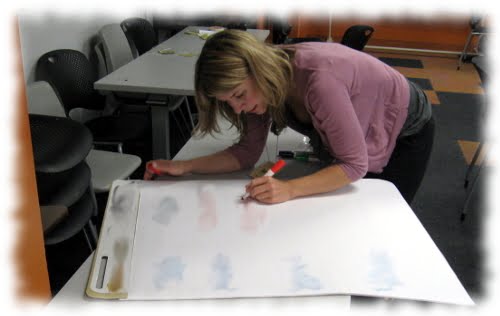Participatory Drama Rubric, aka "Rubric on the Wall Assessment"
Assessment in the arts can be spontaneous and interactive while providing the teacher or leader with clear collectable data. One of my favorite formative assessment strategies that challenges students to self-assess, gets participants moving in many directions, and sparks discussion is the Rubric on the Wall assessment which I developed in the late 1980’s. Because I have seen this assessment process having great impact on student achievement, it is my hope you will try it not just in drama but in other subjects as well. I will break it down into steps.
- 1. CATEGORY SHEETS
Make four large sheets of paper with the headings of your Rubric Categories in the middle of each sheet. I use large post it paper. My standard rubric categories for drama are:
- Academy Award
- Leading Actor
- Understudy
- Back to Acting School
There are many categories that you can use, including the standards: Exceeds, Meets, Does Not Meet, and No Attempt. If the students are not readers, I often add illustrations for the categories on the poster. NOTE: I don’t write anything else on these sheets (posters) so that I can use them over and over again. I often laminate them if I am using smaller posters – but I prefer the large paper.
- 2. DETERMINE WHAT YOU WANT TO ASSESS
If the students are readers, determine ONE skill or criteria that you want to assess during or following the lesson. Tape the corresponding rubric descriptor to the appropriate category sheet. (I have many rubrics on line at onestopdramashop.com that you can download for use.) If students are NOT readers, present the content to them orally or through physical demonstration. NOTE: Sometimes I skip this step and just put up the blank category sheets and hand out the entire rubric, with all descriptors to the participants. See step 9 below.
- 3. HANG THE POSTERS
Put one poster on each wall of the room or as far apart as possible.
- 4. REVIEW
At some point during or at the end of the lesson (formative or summative assessment) review the categories and the criteria descriptors (the rubric) with the students.
- 5. MOVING TO THE POSTERS
En masse, have the participants select and stand by the poster they believe exemplifies their work in applying the criteria/trait to the drama activity or story.
- 6. DISCUSSION
Have the students at each poster discuss with each other why they chose that poster.
- 7. REREAD THE DESCRIPTORS
Reread the descriptors of each poster, having the students listen carefully to determine if they are at the correct poster. Give the students time to switch positions if they feel they should have made a different choice.
- 9. PERSONAL TESTIMONIES
When students have stopped moving and have made their final poster choice, I then call on one or two students by each poster to share aloud why they chose that poster. Often there will be additional switching happening as students listen to each other describing how their work matched or did not match the criteria descriptor. NOTE: I don’t correct the students or tell them where they should stand, but I do note the choices they make to see who incorrectly believes they were demonstrating mastery of a skill and perhaps needs more metacognition about their own work. This allows me to plan strategies to assist the student in their metacognitive work.
AN ALTERNATE PLAN
An alternate plan to taping descriptors on the posters: Hand out and review a printed rubric with the students at the beginning of class. This printed rubric might include several skills with the descriptors for each. Then students, with rubric in hand, can self-assess any criteria you select on the rubric at any point during the lesson using the posters to share their self-assessment.
© 2012, Karen L. Erickson, All Rights Reserved
Members can find many assessments on OneStopDRAMAShop.com written for each grade level and aligned to National Standards.











